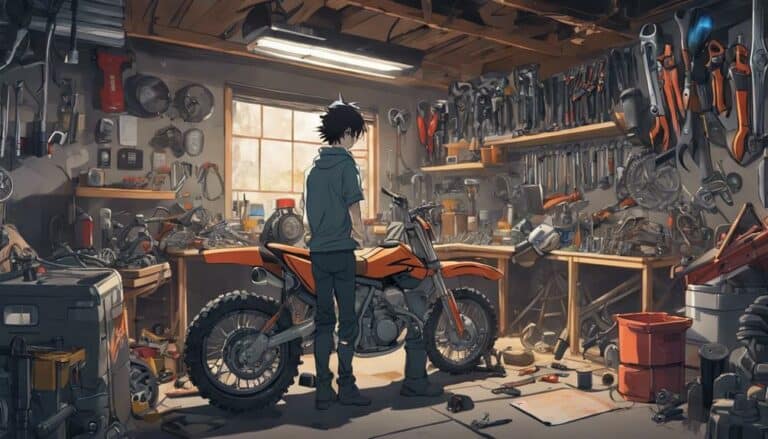Swapping the engine on a dirt bike is like solving a complex puzzle; each piece must fit precisely for the whole picture to come together. As you contemplate this task, envision the intricacies involved in disassembling and reassembling critical components to make sure seamless integration.
The challenge lies not only in physical labor but also in strategic planning and problem-solving. Stay tuned to discover practical tips and insights on overcoming obstacles and achieving a successful engine swap that will elevate your dirt bike's performance to new heights.
Key Takeaways
- Frame compatibility evaluation is crucial.
- Proper alignment of output shafts is essential.
- Consider drive chain positioning carefully.
- Weld or fabricate mounts as needed for successful engine swap.
Engine Swap Complexity Factors
When starting on an engine swap, carefully evaluating frame compatibility and addressing any necessary modifications is key to overcoming the challenges associated with this process.
Engine swaps can be challenging if the new engine doesn't align with the mounting points on the frame. Ensuring that the frame is compatible with the new engine is essential for a successful swap. Frame modifications may be necessary to accommodate different engine sizes.
Welding or custom fabrication of mounts might be required to securely fit the new engine onto the frame. The alignment of output shafts and drive chain positioning are also critical aspects to take into account when evaluating frame compatibility. Without proper alignment and positioning, the engine may not function at its best or could even cause damage to the bike.
Hence, when starting on an engine swap, carefully evaluating frame compatibility and addressing any necessary modifications is key to overcoming the challenges associated with this process.
Necessary Tools and Equipment
To commence the engine swap process on a dirt bike, gather necessary tools and equipment essential for the removal and installation tasks. Here is a breakdown of the tools and equipment you may need:
| Tools | Equipment | Specialized Tools |
|---|---|---|
| Socket set | Engine stand | Impact driver |
| Wrenches | Chain breaker tool | Flywheel puller |
| Screwdrivers | Motorcycle lift | Piston stop tool |
| Torque wrench |
These tools are important for efficiently swapping out the engine on your dirt bike. Remember to wear safety gear like gloves, goggles, and hearing protection to maintain your well-being during the process. Additionally, having the service manual for your specific dirt bike model will provide detailed instructions tailored to your bike, aiding in a smooth engine swap. With the right tools, equipment, and safety precautions in place, you'll be well-equipped to handle the installation of your new engine effectively.
Steps for Engine Swap Preparation
Begin by scrutinizing the compatibility of the new engine with the frame through a thorough comparison of dimensions and mounting points. Make sure the new engine fits seamlessly into the small bike's frame for a successful swap.
To prepare effectively for the engine swap, follow these steps:
- Gather the necessary tools, including wrenches, sockets, and a service manual for reference.
- Set up a well-lit, clean, and spacious area to comfortably work on the engine swap.
- Prior to beginning the swap, disconnect the battery and drain fluids to ensure safety during the process.
- Take detailed notes or photos during the disassembly phase to assist in reassembly and for troubleshooting purposes.
- Confirm that the mounting points on the new engine align correctly with the frame of the small bike to avoid any complications during the swap process.
Engine Removal Process
For a smooth engine removal process, start by disconnecting the exhaust, intake, and electrical components. Begin by removing the gas tank to access the engine area more easily.
Drain the oil and coolant to prevent spills and keep the work area clean. Next, locate and loosen the engine mounting bolts securing the engine to the frame. Be sure to disconnect any additional components like cables and hoses connected to the engine.
Once everything is disconnected, use an appropriate lifting mechanism to carefully extract the engine from the frame. Guarantee that the engine is adequately supported and aligned during the removal process to prevent any damage to the bike or engine components.
Engine Installation and Testing
When installing and testing a new engine on your dirt bike, make sure proper alignment of the engine output shaft/sprocket for best performance. This alignment is critical to prevent premature wear on the components and guarantee efficient power transfer.
Here are some key steps to contemplate:
- Check Rear Sprocket Alignment: Proper alignment of the rear sprocket with the engine output shaft is essential for smooth power transmission.
- Verify Chain Tension: Adjust the chain tension to the manufacturer's specifications to prevent slippage or binding.
- Perform Engine Compression Test: Test the engine's compression to ensure proper sealing and combustion efficiency.
- Conduct Gear Shifting Test: Test the gear shifting mechanism to guarantee smooth transitions between gears.
- Adjust Carburetor Settings: Fine-tune the carburetor settings to optimize fuel-air mixture for the new engine's requirements.
Following these steps diligently will help you install and test the new engine effectively, ensuring excellent performance and longevity.
Conclusion
To sum up, engine swapping a dirt bike requires meticulous planning, thorough research, and precise execution.
While it may present challenges, the process can ultimately result in a more powerful and rewarding riding experience.
By addressing compatibility issues, ensuring proper installation, and optimizing performance, you can achieve a seamless engine swap that enhances the overall performance of your dirt bike.

